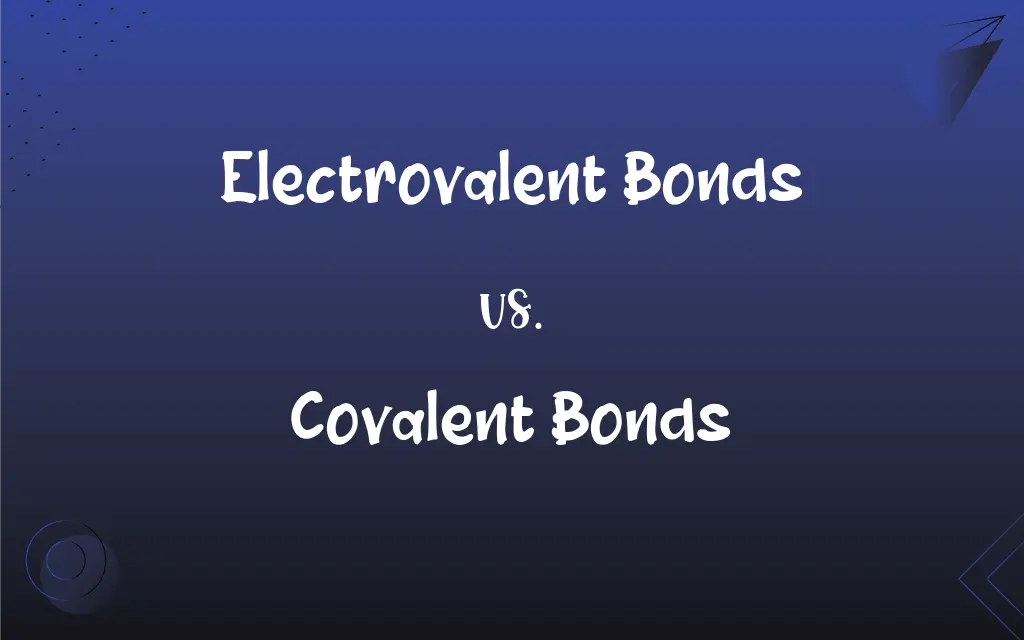Electrovalent Bonds vs. Covalent Bonds: What's the Difference?
Edited by Aimie Carlson || By Janet White || Published on January 19, 2024
Electrovalent bonds involve electron transfer and ionic compound formation, while covalent bonds involve electron sharing and molecule formation.

Key Differences
Electrovalent Bonds form through the complete transfer of electrons from one atom to another, resulting in ions. These ions are held together by electrostatic forces. Covalent Bonds, in contrast, occur when two atoms share electrons, resulting in a molecule. This sharing can be equal or unequal, affecting the molecule's properties.
In Electrovalent Bonds, one atom becomes a positively charged cation and the other a negatively charged anion. This bond typically forms between metals and nonmetals. Covalent Bonds are common between nonmetal atoms, where electrons are shared to fulfill each atom's octet rule, leading to a more stable configuration.
Electrovalent Bonds generally create solid compounds at room temperature, with high melting and boiling points due to strong ionic bonds. Covalent Bonds, however, can result in various states of matter, with generally lower melting and boiling points, as the intermolecular forces are weaker.
The compounds formed by Electrovalent Bonds are usually soluble in water and conduct electricity when dissolved, due to the presence of free ions. Covalent Bonds form molecules that are often insoluble in water and do not conduct electricity, as there are no free ions.
Electrovalent Bonds are characterized by the formation of a crystalline lattice structure, providing rigidity and strength. Covalent Bonds lead to the creation of molecules that can have different shapes and structures, affecting their chemical properties and interactions.
ADVERTISEMENT
Comparison Chart
Type of Elements Involved
Metals and nonmetals
Nonmetals
Electron Movement
Transfer of electrons
Sharing of electrons
Resulting Structure
Ionic compounds, crystalline lattice
Molecular compounds, various shapes
Physical State & Properties
Solid, high melting/boiling points
Various states, lower melting points
Conductivity
Conductive in solution
Non-conductive
ADVERTISEMENT
Electrovalent Bonds and Covalent Bonds Definitions
Electrovalent Bonds
A bond formed by the complete transfer of electrons between atoms.
Sodium chloride (table salt) is formed by an electrovalent bond between sodium and chlorine.
Covalent Bonds
A bond where atoms share one or more pairs of electrons.
In a water molecule, oxygen and hydrogen atoms are linked by covalent bonds.
Electrovalent Bonds
This type of bond involves a metal donating electrons to a nonmetal.
In calcium fluoride, the electrovalent bond occurs as calcium donates electrons to fluorine.
Covalent Bonds
Covalent bonds can form between similar or different nonmetals.
In carbon dioxide, covalent bonds join one carbon atom to two oxygen atoms.
Electrovalent Bonds
Electrovalent bonds create ions with opposite charges that attract each other.
In magnesium oxide, the electrovalent bond results in a strong attraction between magnesium and oxygen ions.
Covalent Bonds
Electrons in covalent bonds are shared in defined orbitals.
In ammonia, three hydrogen atoms share their electrons with a nitrogen atom through covalent bonds.
Electrovalent Bonds
Electrovalent bonds are characteristic of ionic compounds.
Potassium bromide, an ionic compound, is held together by electrovalent bonds.
Covalent Bonds
These bonds result in the formation of molecules.
Methane is composed of one carbon atom and four hydrogen atoms connected by covalent bonds.
Electrovalent Bonds
These bonds are formed through a process of ionization.
The electrovalent bond in lithium iodide involves the ionization of lithium and iodine.
Covalent Bonds
Covalent bonds can be single, double, or triple based on the number of shared electron pairs.
Oxygen gas (O2) features a double covalent bond between its two oxygen atoms.
FAQs
Do electrovalent bonds conduct electricity?
Yes, but only when dissolved in water or melted, as ions become free to move.
Are covalent bonds stronger than electrovalent bonds?
It depends on the context; covalent bonds are strong within molecules, but electrovalent bonds form stronger crystalline structures.
What distinguishes electrovalent from covalent bonds?
Electrovalent bonds involve electron transfer and ion formation, while covalent bonds involve electron sharing between atoms.
Can a compound have both electrovalent and covalent bonds?
Yes, some compounds, like ammonium chloride, have both types of bonds.
Are all ionic compounds formed by electrovalent bonds?
Yes, ionic compounds are the result of electrovalent bonding.
How do atoms achieve stability in covalent bonding?
Atoms share electrons to achieve a full outer electron shell, leading to stability.
What is an example of a covalent bond?
The bond in a water molecule (H2O) is an example of a covalent bond.
Why do metals and nonmetals form electrovalent bonds?
Metals tend to lose electrons while nonmetals gain them, leading to electrovalent bonding.
Do covalent bonds change the state of matter of elements?
They can, as they combine atoms into molecules, altering physical properties.
Can electrovalent bonds form molecules?
No, electrovalent bonds form ionic compounds, not molecules.
Can covalent bonds exist in solid state?
Yes, but the resulting solids are generally softer and have lower melting points compared to ionic solids.
Do electrovalent bonds result in a fixed shape?
Yes, they usually form a crystalline structure with a fixed shape.
Can covalent bonds conduct electricity?
Generally, no, as there are no free ions or electrons.
Do electrovalent bonds involve sharing of electrons?
No, they involve complete transfer of electrons.
Why are covalent bonds important in organic chemistry?
They form the basis of most organic compounds, including life's essential molecules.
How do electrovalent and covalent bonds affect boiling points?
Electrovalent compounds have high boiling points due to strong ionic bonds, while covalent compounds usually have lower boiling points.
What types of structures do electrovalent bonds form in solids?
They form crystalline lattice structures.
Are electrovalent compounds soluble in water?
Generally, yes, because of their ionic nature.
Can electrovalent bonds form between two nonmetals?
No, they typically occur between metals and nonmetals.
Are molecules formed by covalent bonds always gases?
No, they can be gases, liquids, or solids.
About Author
Written by
Janet WhiteJanet White has been an esteemed writer and blogger for Difference Wiki. Holding a Master's degree in Science and Medical Journalism from the prestigious Boston University, she has consistently demonstrated her expertise and passion for her field. When she's not immersed in her work, Janet relishes her time exercising, delving into a good book, and cherishing moments with friends and family.
Edited by
Aimie CarlsonAimie Carlson, holding a master's degree in English literature, is a fervent English language enthusiast. She lends her writing talents to Difference Wiki, a prominent website that specializes in comparisons, offering readers insightful analyses that both captivate and inform.






































































